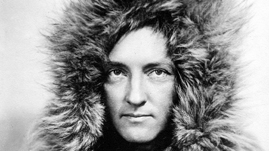Teachers' Domain - Digital Media for the Classroom and Professional Development
User: Preview

Source: ThinkTV
In the midst of the Great Depression, the imagination of Americans was captured by weekly radio broadcasts from Antarctica, transmitting human voices from the base camp established by Admiral Richard E. Byrd for his polar research expedition. The 1934 CBS broadcasts and daily newspaper accounts were among Admiral Byrd’s many technological and scientific "firsts" that fanned public interest in Antarctica and ushered in the modern age of polar exploration.
Admiral Byrd (1888–1957) had already made headlines on his previous trip to Antarctica in 1928–29, when he made the first-ever flight over the South Pole. His was the first American expedition to explore Antarctica since 1840. But the journey to Antarctica had not been easy, taking two months on a fleet of four ships carrying three planes, 42 men, nearly 100 dogs, and 650 tons of supplies, including 40 tons of dog biscuits. Upon arrival, the expedition members hurried to set up their base camp, christened Little America, working in sub-zero temperatures. Byrd’s expedition was the first to utilize the airplane, an aerial camera for mapping, snowmobiles, and wireless communications resources. In spite of the modern vehicles he brought, Byrd often relied on sled dogs, which were far more reliable in the freezing conditions. After 14 months, Byrd returned home to a hero's welcome.
On his second expedition to Antarctica in 1933–35, Byrd and his team of scientists conducted extensive geographical and geophysical explorations, as well as biological investigation of life forms ranging from seals to plankton. One of Byrd's primary objectives was to make daily meteorological observations throughout the Antarctic winter. He and his men built an underground meteorological station; only the radio antennae, the 12-foot anemometer pole, and the shelter for the instruments could be seen above the snow. Admiral Byrd decided to spend the winter there alone, 123 miles from the base camp—a decision that nearly cost him his life.
At first things went well, and Admiral Byrd took meteorological observations twice a day and communicated by radio with the base camp three times a week. But Byrd became ill, not realizing at first that he was suffering from carbon monoxide poisoning due to poor ventilation for the stove and generator. He finally collapsed during a radio communication, causing alarm on the part of his team members, who staged a dangerous rescue mission. Byrd barely survived.
Although his health was damaged, Admiral Byrd made three more expeditions to Antarctica, and remained a champion of polar exploration until his death in 1957. Others scientists have continued to build on his work, using his observations as the baseline for modern research.
Here are suggested ways to engage students with this interactive feature and with activities related to this topic.
 Loading Standards
Loading Standards